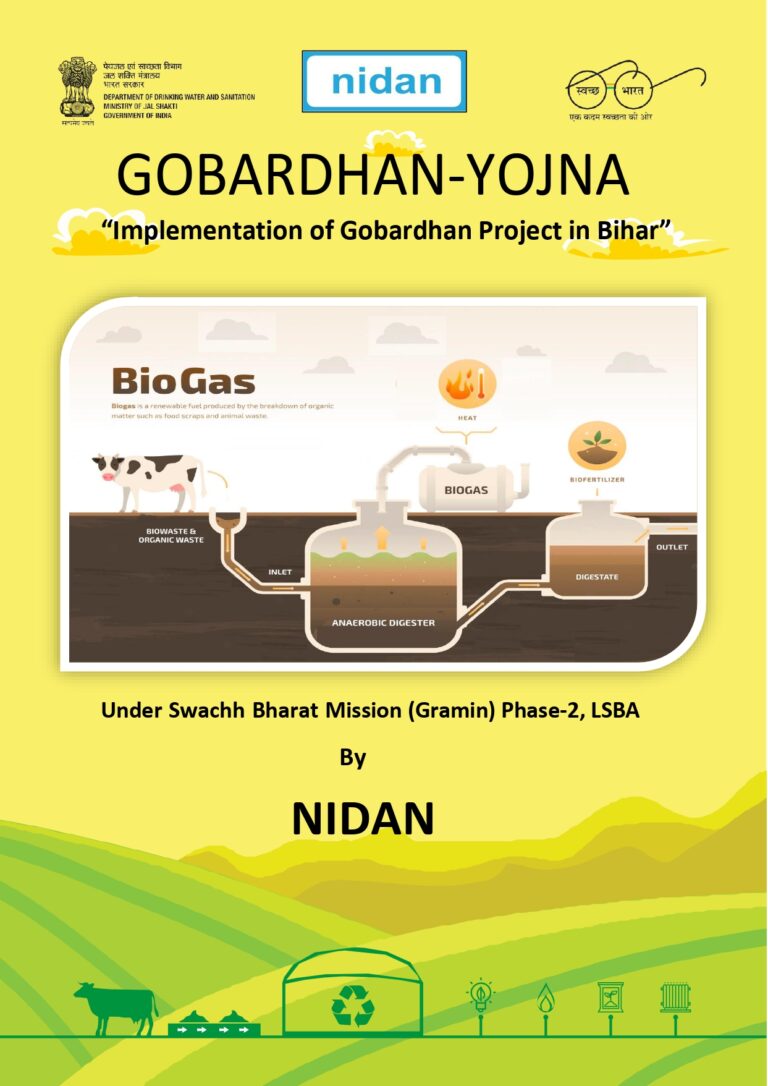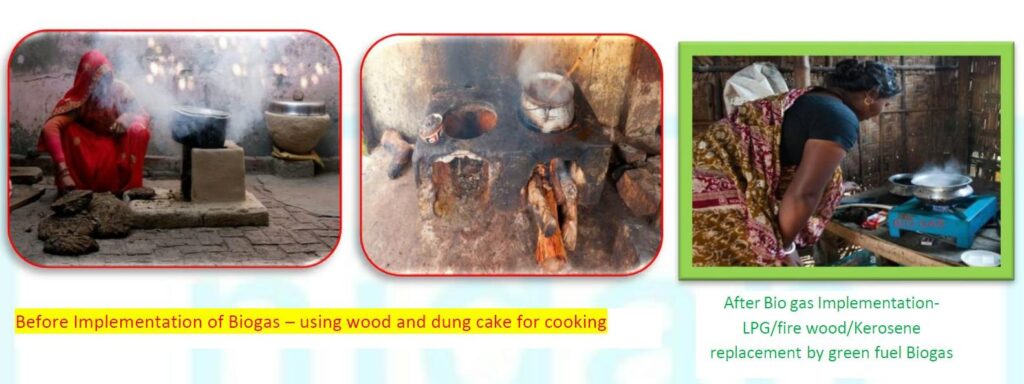BACKGROUND
GOBARDHAN was launched by the Government of India in April 2018 as a part of the Solid and Liquid Waste Management component under Swachh Bharat Mission (Grameen) to positively impact village cleanliness and generate wealth and energy from cattle and organic waste. The main focus of GOBARDHAN is to keep villages clean, increase the income of rural households, and generate energy and organic manure from cattle waste.
As rural India has already attained the Open Defecation Free (ODF) status, the importance of GOBARDHAN has increased as it supports the villages in achieving ODF-plus status, which is an important objective of Swachh Bharat Mission (Grameen) Phase II.
Presently, various Ministries/Departments are implementing schemes for the management of cattle and agricultural waste through the setting up of biogas plants. However, a unified approach would be beneficial to ensure convergence among various schemes and to get full benefits from them. Accordingly, GOBARDHAN: Waste to Wealth programme has been designed to provide a common platform for schemes of different Ministries/Departments such as the Ministry of New and Renewable Energy (MNRE); Ministry of Petroleum and Natural Gas (MoPNG); Department of Animal Husbandry and Dairying (DAHD); Department of Agriculture, Cooperation and Farmers Welfare (DACFW); Department of Rural Development; and Department of Drinking Water and Sanitation (DDWS).

Technical Agencies Empanelled
by States for GOBARdhan
List_of_Technical_Agencies12.01.2023
DDWS is the coordinating Department for implementation of GOBARDHAN: Waste to Wealth programme. DDWS also provides technical and financial assistance to States/UTs for the implementation of GOBARDHAN projects under SBM-G.
CONCEPT OF THE PROJECT:
Biogas based different applications has been understood and proved as a viable alternative to conventional fuel use in households particularly in rural households wherein women and children suffer from grave respiratory and other health diseases due the usage of conventional fuels. All aspects of the domestic biogas production process are known to lead to overall sustainable development in the region of implementation. Given the immense potential and appropriateness of domestic biogas as a developmental level for rural communities the government instituted the Swachh Bharat Mission SBM PHASE -2 (G) Programme.
The proposed project will provide biogas to in proposed village of district, of Bihar State of India. The project will reduce the amount of fuel wood and kerosene used for cooking with cleaner biogas. The project will also reduce methane emissions from the animal manure and other waste and will contribute to the sustainable development of the rural households involved in the project.
An initial survey has indicated that all families in this village uses like Firewood, Kerosene, dung cake and LPG for cooking purposes. In this project the village Proposed the Biogas installation through SBM PHASE-2 (G) concept, proposed project aims at establishing Fixed dome type Thermal cooking Based Biogas plant along. In first phase, gas will be supplied to household peoples in village for their cooking purpose.
Hence the project activity reduces the GHG emissions into the atmosphere by displacing use of dung cake, kerosene and firewood for cooking and promotes the use of biogas as a renewable energy source while minimizing the requirement of fossil fuel.
PROJECT MAJOR OBJECTIVES: –

i. To support villages safely manage their cattle and agricultural waste, and make the villages clean
ii. To support communities in converting cattle and organic waste into wealth using treatment systems
iii. To convert organic waste, especially cattle waste, to biogas and organic manure for use in rural areas
iv. To promote environmental sanitation and curb vector-borne diseases through effective disposal of waste in rural areas


1. Benefits of GOBAR-Dhan:
- GOBAR-Dhan helps in managing a major portion of solid waste in villages e., cattle dung and agricultural waste and promotes environmental sanitation.
- Substantially reduces vector-borne diseases and promotes public
- Promotes household income and saving as the use of biogas reduces the expenditure on
- Helps in generating organic manure which enhances agriculture and farm productivity
- Promotes employment and income generation opportunities for SHGs/ farmers
- Helps in reducing carbon emission and promotes environmental
- Helps to save foreign exchange by reducing the need for the import of natural
Benefits of Biogas:
1. Health Benefits
The advantages of a biogas plant for the health of a rural community are four-fold; uncovered faecal waste (animal) is removed from open areas, direct exposure of people to waste is eliminated. Therefore, in the area of public health and pollution control, where disposal of wastes is usually the major problem is easily eliminated. With that the associated health related problems are also eliminated. Dung waste are deposited directly into digester; the village is no longer littered with animal wastes, so hygiene immediately improves.
Digestion of these waste can reduce the parasitic and pathogenic bacteria counts up to 90%, breaking the vicious circle of infection via drinking water, which in many rural areas is untreated.
As woman no longer have to spend hours away from their homes, traveling distances to collect wood for cooking and heating, they can free up valuable time for activities, which they would otherwise be unable to do. Their overall health improves due to better cooking conditions and decrease in respiratory diseases.
2. Agricultural benefits:
Biogas technology is also potentially useful in the recycling of nutrients back to the soil. Burning non-commercial fuel sources, such as dung and agricultural residues, in our country are used as fuel instead of as fertilizer, leading to a severe ecological imbalance, since the nutrients, nitrogen, phosphorus, potassium and micro-nutrients, are essentially lost from the ecosystem. Biogas slurry preserves the nutrients, which can be recycled back to the land. The organic digested material also acts as a soil conditioner by contributing humus. The bio- slurry discharged from installation retains all the nutrients present in the original material, and it constitutes an excellent organic fertilizer. Normally fertilizing and conditioning soil can be achieved by simply using the raw manure directly back to the land without fermenting it, but anaerobic digestion produces a better material. Proper application of this manure produces higher yields than nutrient depletion.
Biogas installation reduces the demand for firewood, mitigating deforestation. Applying bio-slurry as an organic fertilizer closes nutrients cycles, and halts soil degradation and erosion.
3. Environmental benefits:
Biogas plant improves air quality. Through Biogas plant, Methane gas is captured and utilized that would have otherwise entered into atmosphere from manure. Uncontrolled methane is a toxic greenhouse gas, 20 times more harmful to the atmosphere than carbon dioxide.
The biogas process is carbon neutral, contributing to the global reduction of greenhouse gas emissions. It helps controlling undesirable nutrients in soil and surface water supplies. It helps in reducing odour created by organic waste.
4. Resource benefits:
Production of energy (Gas and Manure); Energy generation plays a major role in supplementation small energy generation for Cooking, heating, and It lowers demand for natural gas and other finite supplies of fossil fuel. It being up to 100 percent renewable reduces dependence upon finite fossil fuels. It provides economic benefits through energy and fertilizer substitution. It provides additional income sources and increasing yields of animal husbandry and agriculture.
It has the potential to provide large- scale generation of rural employment for local masons, unskilled labours, supervisors, turnkey workers and biogas accessory manufacturers; all roles’ women can fulfil as well as men. In this way, rural communities have greater opportunities to earn a living and become self- reliant and in turn conserve and protect their local environment.
5. Reduction of the Greenhouse Effect:
Last but not least, biogas technology takes part in the global struggle against the greenhouse effect by reducing the release of CO2 from burning fossil fuel in two ways. First, biogas is a direct substitute for gas or coal for cooking, heating. Second, the reduction in the consumption of artificial fertilizer avoids carbon dioxide emissions that would otherwise come from the fertilizer –producing industries.
Methane, the main component of biogas is itself a greenhouse gas with a much higher “greenhouse potential” than CO2. Converting methane to carbon dioxide through combustion is another contribution of biogas technology in the mitigation of global warming. However, this holds true only for the case that the material used for biogas generation would otherwise undergo anaerobic decomposition, thereby releasing methane into the atmosphere. There is no net intake of carbon dioxide in the atmosphere from biogas burning, as is the case when burning fossil fuels.
All these attributes make Biogas Technology a clean technology and apt candidate for benefits of Carbon Credits under Clean Development Mechanism.
Bio Gas Model
FIXED DOME BIOGAS PLANT


About Biogas
Biogas is an environmentally-friendly, renewable energy source. It’s produced when organic matter, such as food or animal waste, is broken down by microorganisms in the absence of oxygen, in a process called anaerobic digestion.
It’s a mixture of gases (containing predominantly methane ) produced by the microbial activity and which may be used as cooking, lighting , after purifier as vehicle fuel.
Cow dung is the main source for the biogas as the bacteria in dung has more potential than others.
Biogas is produced by processing residual waste from livestock (dung, manure and uneaten food and any biodegradable natural waste. ), food production (fruit and vegetable waste, residues from meat, fish and dairy processing, brewery waste, food waste and much more) and effluents from industrial as well as municipal wastewater treatment plants. By constructing biogas power plants, agriculture assumes an important contribution to supplying energy from renewable resources as well as to the disposal of organic wastes. Digestate are produced as a by-product of biogas manufacturing, which can in turn be used as high-quality digestate.
The implementation of the Recycling and Waste Management Act is perfectly implemented with the construction of rural biogas power plants from an economic and environmental perspective.
Anaerobic digestion is widely used as a renewable energy source because the process produces a methane and carbon dioxide rich biogas suitable for energy production, helping to replace fossil fuels. The nutrient-rich digestate which is also produced can be used as fertilizer.
Anaerobic Digestion is a waste to energy conversion process – it is not a waste “disposal” process. It has “reduce, reuse, and recycle” approach to lessening the pollution load, better as a plant fertilizer &release of renewable energy”
Synopsis: Bio waste has energy left into it which can be converted into Biogas. Raw Biogas can be obtained from Biomass aerobic digestion. The raw biogas contains 55-65% methane which is use directly in thermal use (as a cooking) and biogas purified more than 96% which can be used for industrial purposes.
IMPACT OF BIOGAS PLANT
- Domestic biogas used as cooking fuel is used exclusively by village / rural people and they are the ones who benefit the most directly from it. Increased efficiency & electricity effectiveness along with producing good bio-organic manure which perhaps the most conspicuous benefit of
- Biogas users also benefit from improved indoor air quality and health, as biogas is smokeless. This is especially relevant when it comes to respiratory and visual health
- High quality generated fertilizer in the form of Bio slurry can be used to improve crop yields thus becoming an income generating asset for village, Further-more it saves users the expense and the hazard of using chemical
- Biogas is clearly a sustainable fuel in the medium- and long-term future which will save our
- By providing a new, sustainable source of Cooking Gas and organic fertilizer (bio slurry), it is hoped that widespread use of biogas will contribute to preserving the long-term economic and environmental health of rural Proposed
CONTRIBUTION OF THE PROJECT ACTIVITY TO SUSTAINABLE DEVELOPMENT:
a. Social Benefits
b. Economic Benefits
c. Environmental Benefits
Social Benefits
Job creation for local people – The Project activity will provide direct employment opportunities and indirect employment opportunities to the local peoples. They will be trained to maintain, troubleshoot, and monitor the biogas plant.
- Health improvement – smell reduction, flies & pathogen reduction due to utilization of clean, green energy & end products use as organic fertilizer instead of chemical
- Sanitation: with proper management of animal and other agriculture/organic wastes
- Village will be clean leading to better health and hygiene in rural
- The installation of a biogas plant will solve the cooking problem , by participating households will through this gas they can avail more benefits and can-do good irrigation with
- Especially good for women as it prevents indoor
- Lifestyle Improvements

- Economic Benefits
Biogas can be used as a fuel alternative to Kerosene, Fire wood, LPG in Kg, Charcoal, Dry Dung etc.
Equivalent Quantity of Fuels vs Biogas
| Name of Fuel | Kerosene in Litre | Fire wood in Kg | LPG in Kg | Charcoal in Kg | Dry Dung in Kg |
| Equivalent Quantities Of 1 m³ of Biogas | 0.620 L | 3.474 Kg | 0.456 kg | 1.458 Kg | 12.296 Kg |
| Volume | 0.62 | 3.474 | 0.456 | 1.458 | 12.296 |
C. Environmental Benefits
- Protect forest – reduce the pressure on scarce forest resources in the project area. Protect ground water from contamination
- Prevent the ozone layer.
- Clean environment
Benefits to the Nation
- Developed countries have been pointing at developing and under developed countries as responsible for GHG, while the fact is By reducing emission of hazardous gases, credit will be made available to developed countries. Thus, India can boast of positively and actively contributing in reducing Greenhouse effect.
- Energy saved is energy generated under the prevailing energy conditions utilization of such non-conventional energy sources would boost the energy profile of the
- The cattle dung and kitchen waste treatment will not only lower energy input but also with energy generation would be important from environmental safety view
- Experience gained and successful operation of such a project would undoubtedly start a chain of such projects for similar nature, thereby reducing the external energy needs of our nation and thus achieving overall saving of conventional
- Conservation of natural
Design Selection For The Project
Fixed Dome


